![]()
![]()
![]()
Use LEFT and RIGHT arrow keys to navigate between flashcards;
Use UP and DOWN arrow keys to flip the card;
H to show hint;
A reads text to speech;
26 Cards in this Set
- Front
- Back

What family is this? |
Arecaceae (Palmae): Isodiametric trunk, leaves form crown shape at top of plant. - Roots are present only at bottom, leaves only at the top. - Fruits are fundamental for birds, insects, & mammals. |
|
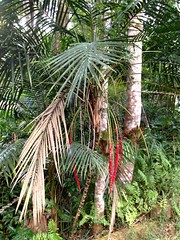
What family is this? |
Arecaceae (Palmae): Isodiametric trunk, leaves form crown shape at top of plant. - Roots are present only at bottom, leaves only at the top. - Fruits are fundamental for birds, insects, & mammals. |
|
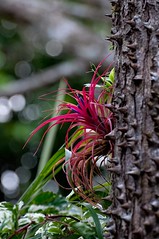
What family is this? |
Bromeliaceae: Family of pineapple. -Mostly epiphytes and can be identified by form of leaves (grow in rosette) that forms a particular ecosystem inside: phytotelmata. -The inflorescence has tubular flowers supported by bracts. Puya (paramo) is very popular as is bromelia genus. |
|

What family is this? |
Cyclanthaceae: Most have bifurcated or palmated leaves (may look like young palm) but the growth of leaves and roots will be together and not separated--each node has it’s own root and leaf. * A veces, las frutas parecen como maíz. |
|
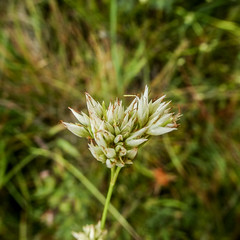
What family is this? |
Cyperaceae: Stem has triangular form from base to the start of flowers. Flowers group in clusters of spikelets. Papyrus is the most famous species (Cyperus papyrus).
|
|

What family is this? |
Heliconiaceae: Inflorescence is very particular: large peduncle (stem supporting inflorescence) and a series of bracts that hold flowers and fruits. Famous as it is bird of paradise. |
|
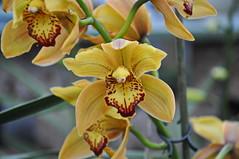
What family is this? |
Orchidaceae: Epiphytes. Named as the roots looked like testicles (orchis in greek) by Teofrastos (greek philosopher). More than 25,000 species, with 5,000 in Ecuador. Has 3 sepals and 3 petals, with one being modified and called a labellum. Some species have pseudobulbs at base for reservoirs of water and nutrients. Fruits are dehydrated capsules, seeds are simple and numerous (thousands released at once, look like a powder). They must find a fungus to develop into a new plant (mycorrhiza: symbiotic association between a fungus and the roots of a vascular plant). 97% of orchids have a single pollinator. Can be monopoidal (growing from one verticle stem), or sympoidal (growing from multiple horizontal stems). Lacks a permanently woody structure. |
|

What family is this? |
Poaceae: Grasses: monocot, has roots that spread out. When you cut it has a mustache at the base of the leaf, called a ligula * includes corn (Zea mays) and caña Guadua (Guadua angustifolia- bamboo cane?) |
|
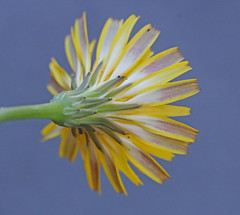
What family is this? |
Asteraceae: Family of dandelion * Flower is supported by a conjunction of bracts |
|

What family is this? |
Begoniaceae: * fruits are triangular capsules |
|

What family is this? |
Bignoniaceae: Most important family of lianas * Flores tubulares y vistosas (colorful). Often have 2 pairs of stamen in the base of the corolla |
|

What family is this? |
Euphorbiaceae: May have glands at base of leaves and latex. * Sangre de Drago |
|
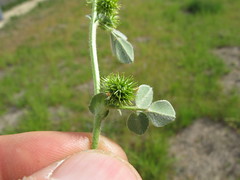
What family is this? |
Fabaceae: (leguminosae). Hojas alternas, en algunos géneros trifoliados. Usualmente compuesta Always have stipules which may be leaf like Flowers have five generally fused sepals and five free petals. 10 stamen and 1 ovary |
|

What family is this? |
Gesneriaceae: Epiphytes, creepers, or bushes. (fuzzy family) Hojas opuestas, with serrated margins Often succulents with visible pubescence Tubular flowers with 4 stamen (2 long and 2 short) Bracts at base of flower that help in pollination process |
|

What family is this? |
Lamiaceae: Mint and oregano family. Mostly bushes. Very aromatic * Tallos son cuadrados, desde la base hasta el apice |
|

|
Lauraceae: Family of avocado -Hojas simples, alternas o opuestas -Small flowers and fruits have single seed -Base of peciolo is ribbed/grooved |
|
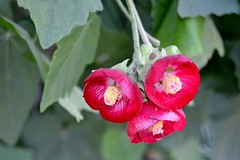
What family is this? |
Malvaceae: Hibiscus genus is in this family * Frutos generalmente secos |
|

What family is this? |
Melastomataceae: hojas simples, opuestas, con los nerviaciones secundarias paralelas. Estambres doblados en las flores como codos. Polinizada por (usualmente) avispas. Importante porque la fruta es comida para muchas aves y animales. |
|
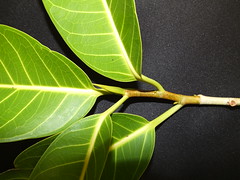
What family is this? |
Moraceae: (fig family) - brochidodromous venation= With a single primary vein, the secondary veins not terminating at the margin but joined together in a series of prominent upward arches or marginal loops on each side of the primary vein (can see basically all the veins) * possess sap |
|
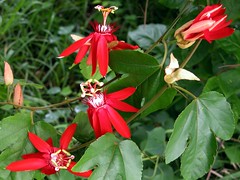
What family is this? |
Passifloraceae: Lianas and creepers, occasionally small trees. Passiflora genus Hojas alternas. Axillary tendrils (slender threadlike appendage of a climbing plant) and sometimes glands by peciolo. Axillary flowers that may have ‘verticilos’ forming a crown. Called passion fruit as gynophore divides into three stigmas that look like a points of a cross. |
|
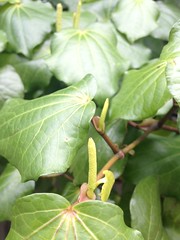
What family is this? |
Piperaceae: Black- pepper family. Very aromatic -Hojas simples y alternas -Thickened nodes. Inflorescence is long with no petals or sepals. |
|
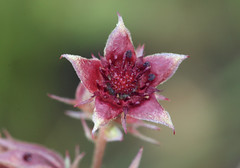
What family is this? |
Rosaceae: Family of roses, blackberries, and apples. -Hojas alternas y compuestas; las estípulas son axilares y triangulares, dando la forma de orejas de caballo. -5 pétalos, 5 sépalos, y muchos estambres -Polylepis genero (Paramo) |
|
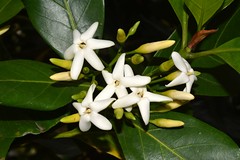
What family is this? |
Rubiaceae: Family of coffee * Flores tubulares, generalmente blancos |
|

What family is this? |
Solanaceae: Family of potato, tomatoes, tobacco, pepper, and chilis. -Pentameric flowers: 5 petals, 5 sepals, 5 estambres -Hojas alternas, simples o compuestas -Olor muy fuerte. High production of alkaloids |
|

What family is this? |
Urticaceae: (“Stinging nettle family”) * Azteca ants colonize the trees, carve small holes in the trunks to access domatia. |
|

What family is this? |
Verbenaceae: Hojas casi siempre son opuestas. The apex (tip) of the branches are square.
|

